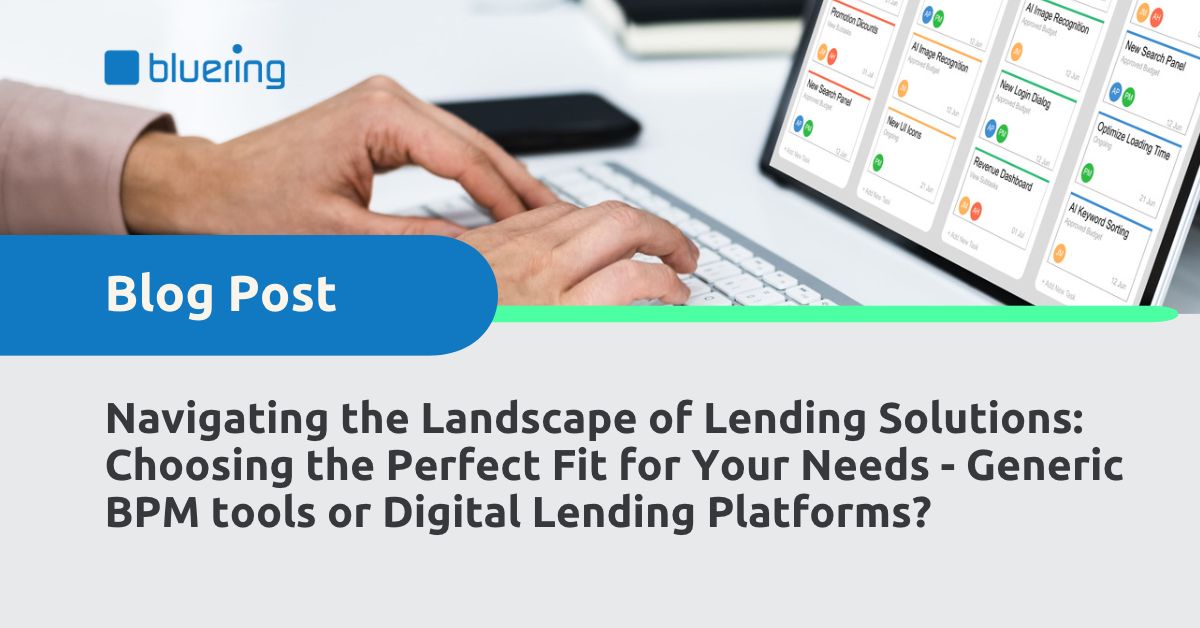In today’s digital era, financial institutions constantly strive to enhance their operational efficiency and customer experience. Two of the most common solutions are business process management (BPM) tools and off-the-shelf digital lending platforms that support bankers in the credit automation process. While both aim to streamline processes, the two have their differences.
In this blog post, we will explore the pros and cons of each to help you understand which solution is best suited for your organization.
Generic Business Process Management Tools:
BPM tools are meticulously designed to optimize and automate various operational processes within an institution. These tools typically offer features such as workflow management, document management, compliance tracking, and reporting. Let’s delve into the pros and cons:
Pros:
- Cost-effective: BPM solutions are priced considerably lower than industry-specific platforms. Moreover, since these tools can automate multiple banking processes beyond lending, they offer cost-effectiveness across the entire bank.
- Streamlined Operations: By leveraging BPM tools, banks can automate complex processes, reducing manual errors and enhancing operational efficiency.
- Improved Collaboration: BPM tools facilitate collaboration among different departments and teams, enabling seamless communication and knowledge sharing.
- Enhanced Visibility: With real-time monitoring and reporting capabilities, BPM tools offer greater visibility into processes, allowing for better decision-making and performance analysis.
Cons:
- Time to Market: Constructing custom automated processes can be time-consuming, potentially causing delays in implementing your BPM solutions.
- Steep Learning Curve: Employees may require training and time to adapt to the new BPM tools, potentially impacting productivity during the transition period.
- Customization Complexity: The implementation and customization of BPM tools to align with specific banking processes can be time-intensive and demand substantial resources.
- Integration Challenges: Integrating BPM tools with existing banking systems and legacy infrastructure may present technical hurdles.
While BPM tools may offer cost-effectiveness, the associated costs of implementation, customization, and integration tend to be considerably high.
Digital Lending Platforms:
Digital lending platforms focus specifically on streamlining and digitizing the loan origination and management processes. These platforms provide end-to-end solutions, from loan application to disbursal and ongoing servicing. Let’s explore their pros and cons:
Pros:
- Specialized and built-in industry specific processes: Digital lending solutions are designed specifically for the lending industry, incorporating industry best practices and tailored processes. They offer built-in workflows and functionalities that align with the unique requirements of lending operations, streamlining the entire lending lifecycle.
- Off the shelf APIs for integration with multiple systems: Most Digital lending solutions come with a built in suite of APIs for seamless integration with multiple systems. This enables lenders to connect and communicate effortlessly with various third-party applications, including credit bureaus, payment gateways, and core banking systems. The integration process is simplified, development time is saved, and lenders can leverage the functionalities of multiple systems within their digital lending platform.
- Fast time to market: Digital lending platforms enable lenders to quickly launch and deploy their lending operations. These solutions offer pre-built workflows, templates, and configurations that accelerate implementation, allowing lenders to go live with their lending platform in a shorter time frame. This agility enables lenders to seize market opportunities, stay ahead of competitors, and start generating revenue sooner.
- Seamless Customer Experience: Digital lending platforms offer borrowers a user-friendly online interface for loan applications, reducing paperwork and simplifying the borrowing experience.
- Faster Loan Processing: Leveraging automation and data analytics, these platforms enable quicker loan approvals, reducing turnaround times, and improving customer satisfaction.
- Personalization and Risk Assessment: Digital lending platforms utilize advanced algorithms to personalize loan offers based on borrowers’ financial profiles, resulting in tailored terms and interest rates. They also facilitate accurate risk assessment, leading to more informed lending decisions.
- Efficient Loan Servicing: Once loans are disbursed, digital lending platforms provide borrowers with self-service capabilities, allowing them to manage their accounts, make payments, and access statements quickly and easily.
Cons:
- Limited Scope: Digital lending platforms primarily focus on the lending process, and may not offer comprehensive banking functionalities beyond loan origination and management.
- Higher Cost: Specialized platforms may come at a higher price tag compared to generic BPM tools, particularly for smaller banks with limited budgets. However, the return on investment from improved efficiency and customer satisfaction can outweigh the initial costs.
- Integration Complexity: Integrating a specialized platform with existing banking systems and infrastructure may require additional effort and technical expertise, potentially posing implementation challenges that necessitate collaboration with the vendor.
- Customization Limitations: While specialized platforms offer industry-specific features, they may have limitations when it comes to independent customization, requiring support from the vendor for customization.
Conclusion:
BPM tools and Digital Lending Platforms serve distinct purposes within financial institutions. While BPM tools focus on optimizing operational processes across the organization, digital lending platforms specifically streamline loan origination and management. The right choice depends on your institution’s priorities and objectives.
When making your decision, consider your organization’s unique needs, such as process automation requirements, customer experience goals, and regulatory compliance concerns. An informed decision, based on a thorough evaluation of the advantages and disadvantages of each solution, will align with your business strategy and enhance your overall banking operations.
